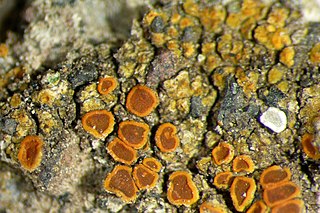Annaperenna verrucosa, common name the warty ranella, is a species of large sea snail, a marine gastropod mollusc in the family Bursidae, known as the frog shells.
Cratiria is a genus of lichen-forming fungi in the family Caliciaceae. The genus has a widespread distribution, especially in tropical regions, and contains about 20 species. The genus was circumscribed by Austrian lichenologist Bernhard Marbach in 2000, with Cratiria lauri-cassiae assigned as the type species.

Gassicurtia is a genus of lichenized fungi in the family Caliciaceae.

Lucy May Cranwell was a New Zealand botanist responsible for groundbreaking work in palynology. Cranwell was appointed curator of botany at Auckland Museum in 1929, when she was 21 years old. As well as her work on ancient pollen samples she was responsible for encouraging a love of botany in a generation of Auckland children.
Sculptolumina is a genus of corticolous lichens in the family Caliciaceae. The genus was circumscribed by Bernhard Marbach in 2000, with Sculptolumina japonica designated as the type species.
Endohyalina is a genus of 10 species of corticolous lichens in the family Caliciaceae. The genus was circumscribed by Bernhard Marbach in 2000, with Endohyalina rappii designated as the type species.
Buellia quarryana is a species of crustose lichen in the family Caliciaceae. Found in southeastern Australia, it was described as a new species in 2020 by lichenologists John Elix and Patrick McCarthy. The type specimen was collected from Quarry Beach in East Gippsland (Victoria), where it was found growing on siliceous rocks along the seashore. The specific epithet refers to the type locality. It has also been found on the coast of southern New South Wales.
Buellia magaliesbergensis is a species of crustose lichen in the family Caliciaceae. Found in South Africa, it was formally described as a new species in 2021 by lichenologists John Alan Elix and Helmut Mayrhofer. The type specimen was collected in the Magaliesberg Range at an altitude of 1,720 m (5,640 ft). Here, the saxicolous lichen was found growing on rocks on the ground. The species epithet refers to the type locality, the only location where the lichen has been documented. The results of standard chemical spot tests are thallus K+ (yellow), P+ (yellow-orange), and C−. Buellia magaliesbergensis contains norstictic acid as a major secondary chemical and connorstictic acid as a minor compound.

Caloplaca allanii is a species of saxicolous (rock-dwelling) and crustose lichen in the family Teloschistaceae. Found in New Zealand, it was formally described as a new species by Alexander Zahlbruckner. The type specimen was collected by Lucy Cranwell on Anawhata Beach in 1932; she sent a dried specimen to Zahlbruckner for identification. The specific epithet allanii honours New Zealand botanist Harry Allan.

Pertusaria allanii is a species of saxicolous (rock-dwelling) and crustose lichen in the family Pertusariaceae. Found in New Zealand, it was scientifically described as a new species in 1941 by Austrian-Hungarian lichenologist Alexander Zahlbruckner. The type specimen was collected from Waiheke Island, where it was found growing on coastal rock. The specific epithet allanii honours the collector, New Zealand botanist Harry Allan. As of 2018, in the New Zealand Threat Classification System, the lichen is considered "At Risk – Naturally Uncommon".
Buellia capensis is a species of crustose lichen in the family Caliciaceae. Found in South Africa, it was formally described as new species in 2021 by John Elix and Helmut Mayrhofer. The type specimen was collected south of Langebaan at an altitude ranging from 80 to 130 m ; here it was found growing on granite from a south-exposed slope. It is only known from the type collection. The contains several secondary compounds, including lichexanthone and secalonic acid A as major metabolites, and trace amounts of fumarprotocetraric acid and succinprotocetraric acid. The specific epithet capensis refers to the region of the type locality.
Tetramelas flindersianus is a saxicolous (rock-dwelling) crustose lichen species in the family Physciaceae. First described scientifically in 2020, it is found in Australia.
Buellia arida is a species of saxicolous (rock-dwelling), crustose lichen in the family Caliciaceae. It occurs in Australia. Buellia arida grows up to 4 cm wide, either concealed within or visible on rock surfaces, forming small, fragmented patches. It features an off-white, dull thallus, numerous black apothecia that become convex over time, and spores that evolve from pale to dark brown, characterized by their ellipsoid shape and finely decorated surface.
Buellia cravenii is a species of saxicolous (rock-dwelling), crustose lichen in the family Caliciaceae. It is found in Australia. The lichen spreads up to 3.5 cm wide thick, forming a continuous, grey-white cracked pattern of areoles.
Buellia kowenensis is a rare species of saxicolous (rock-dwelling), crustose lichen in the family Caliciaceae. It is only known to occur at its original collection site in the Australian Capital Territory of Australia.
Buellia lordhowensis is a little-known saxicolous (rock-dwelling), crustose lichen species in the family Caliciaceae, first described in 2020. It is only known to occur on Lord Howe Island, Australia.
Buellia phillipensis is a little-known species of saxicolous (rock-dwelling), crustose lichen in the family Caliciaceae, described in 2020. It is only known to occur on Phillip Island in the Southwest Pacific.
Baculifera confusa is a species of lignicolous (wood-dwelling), crustose lichen in the family Caliciaceae. It is found in Australia.

Libertia cranwelliae is a species of flowering plant in the family Iridaceae. The plant was first described by Dan Blanchon, Brian Grant Murray and John E. Braggins in 2002, and is native to New Zealand.

Codium cranwelliae is a subtidal seaweed in the family Codiaceae. The green algae is endemic to New Zealand, primary found on the northeastern coast of the North Island.










